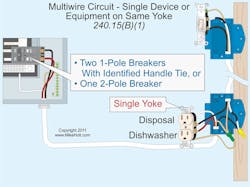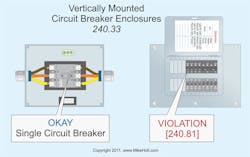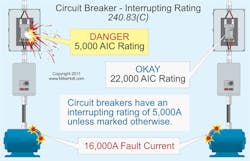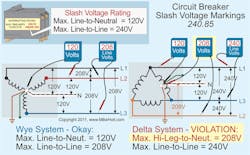Thank you for visiting one of our most popular classic articles. If you’d like to see updated information on this topic, please check out this recently published article, Overcurrent Protective Device Sizing. |
Note: This article is based on the 2011 NEC.
Overcurrent exists when current exceeds the rating of equipment or the ampacity of a conductor. This can be due to an overload, short circuit, or ground fault [Art. 100]. Overcurrent devices protect conductors and equipment from overcurrent. The trick is selecting the correct overcurrent protection for a specific circuit.
Article 240 provides requirements for sufficient overcurrent protection in the correct location. Other Articles may apply to your particular installation (see Table 240.3).
Protecting conductors
The general rule for overcurrent protection is to select an overcurrent protection device (OCPD) that protects conductors based on their ampacities (after ampacity correction and adjustment per 310.15). You must provide the protection where the conductors receive their supply [240.4 and 240.21], but several exceptions to this rule exist [240.4(A) through (G)]:
- Power loss hazard. If circuit interruption will create a hazard (e.g., fire pump circuit), you must provide short circuit protection, but you don’t have to provide conductor overload protection [240.4(A)].
- OCPDs rated 800A or less. If you meet the three requirements of 240.4(B), you can use the next higher standard rating of OCPD listed in 240.6 (above the ampacity of the ungrounded conductors being protected).
- OCPDs rated over 800A. If the OCPD exceeds 800A, the conductor ampacity (after temperature correction, conductor bundling adjustment, or both) must have a rating of at least that of the OCPD defined in 240.6 [240.4(C)].
- Transformer secondary conductors. You can protect the secondary conductors of a 2-wire (single voltage) system with the primary OCPD sized per 450.3(B) as long as that OCPD doesn’t exceed the value determined by multiplying the secondary conductor ampacity by the secondary-to-primary transformer voltage ratio [240.4(F)].
- Specific applications. Overcurrent protection for specific equipment and conductors must comply with Table 240.4(G) references.
Air-conditioning/refrigeration equipment and circuit conductors must be protected against overcurrent per 440.22, and motor circuit conductors must be protected in accordance with Art. 430 [240.4(G)].
Flexible cords and fixture wires
The NEC applies only to premises wiring, not to the supply cords of listed appliances or luminaires or extension cords. For flexible cords and fixture wires not part of an appliance or luminaire assembly or listed extension cord:
- Protect flexible cord with an OCPD sized for its ampacity per Table 400.5(A)(1) or Table 400.5(A)(2) [240.5].
- Protect fixture wires with OCPDs sized for their ampacity per Table 402.5 [240.5].
Ground fault protection
According to 240.13, service equipment and feeder circuits rated 1,000A or more supplied from a 4-wire, 3-phase, 277/480V wye-connected system must be protected against ground faults per 230.95 [215.10 and 230.95], but this requirement doesn’t apply to:
- Continuous industrial processes where a disorderly shutdown will introduce additional or increased hazards.
- Installations where ground fault protection of equipment already exists.
- Fire pumps [695.6(H)].
Ungrounded conductors
A fuse or circuit breaker must be connected in series with each ungrounded conductor [240.15]. Breakers must automatically (and manually) open all ungrounded conductors of the circuit. However, you can use individual single-pole breakers with identified handle ties for:
- Multiwire branch circuits that supply only line-to-neutral loads [240.15(B)(1)] (Fig. 1).
- Branch circuits that supply single-phase, line-to-line loads (120/240V) [240.15(B)(2)].
- Branch circuits that supply 3-phase, line-to-line loads on systems not exceeding 120V to ground [240.15(B)(3)].
Location
Install OCPDs where the branch circuit or feeder conductors receive their power [240.21]. The exceptions to this requirement are:
- Branch-circuit taps, if they meet the requirements of 210.19 [240.21(A)].
- Feeder taps, if they meet the requirements of 240.21(B)(1) through (B)(5). But you can’t use the “next size up protection rule” of 240.4(B) [240.21(B)].
- Transformer secondary conductors, if they meet the requirements of 240.21(C).
- Service conductors, which are protected against overload by the service disconnect overcurrent device per 230.91 [240.21(D)].
- Busway taps, which you can protect per the requirements of 368.17 [240.21(E)].
- Motor circuit taps, which you can protect per the requirements of 430.28 and 430. 53 [240.21(F)].
- Conductors from generator terminals, which you can protect per the requirements of 445.12, if they meet the size requirements of 445.13 [240.21(G)].
- Battery conductors, for which you install the OCPDs as close as practicable to the battery terminals 240.21(H)].
OCPDs must be readily accessible [240.24(A)]. Install them so the center of the grip of the operating handle, when in its highest position, isn’t more than 6 ft, 7 in. above the floor or working platform. The four exceptions to this height requirement are:
- Busways, as provided in 368.17(C) [240.24(A)(1)].
- Supplementary OCPDs [240.24(A)(2)].
- OCPDs described in 225.40 and 230.92 [240.24(A)(3)].
- OCPDs located next to equipment, if accessible by portable means [240.24(A)(4)].
OCPDs must not be:
- Exposed to physical damage [240.24(C)].
- Located near easily ignitable material [240.24(D)].
- Located in the bathrooms of dwelling units, dormitories, or guest rooms/guest suites of hotels or motels [240.24(E)].
- Located over stairway steps [240.24(F)].
Enclosures
In damp or wet locations, enclosures containing OCPDs must prevent moisture or water from entering (or accumulating within) the enclosure. When installing a surface-mounted enclosure in a wet location, leave at least ¼ in. of air space between it and the mounting surface [240.32].
Unless impractical, mount the OCPD enclosure in a vertical position [240.33]. You can mount it horizontally if the OCPD meets the requirements of 240.81 (Fig. 2). Section 240.81 specifies that where circuit breaker handles are operated vertically, the UP position of the handle must be in the ON position. So an enclosure that contains one row of circuit breakers can be mounted horizontally, as long as the circuit breakers are installed so that UP is ON. However, an enclosure that contains a panelboard with multiple circuit breakers on opposite sides of each other must be mounted vertically.
Plug fuses
Plug fuses of 15A or lower rating are identified by a hexagonal configuration of the window, cap, or other prominent part. You can use plug fuses only when:
- The circuit voltage doesn’t exceed 125V between conductors [240.50(A)(1)].
- The circuits are supplied by a system with a line-to-neutral voltage not exceeding 150V [240.50(A)(2)].
Edison-base fuses are classified to operate at not more than 125V and have an ampere rating of not more than 30A [240.51(A)]. You can use them only for replacement in an existing installation where there’s no evidence of tampering or overfusing [240.51(B)]. You can install Edison-base fuseholders only if you install an adapter that lets them accept Type S fuses [240.52].
Type S fuses operate at not more than 125V and have ampere ratings of 15A, 20A, and 30A [240.53(A)].
Cartridge fuses
The two basic designs of cartridge fuses are the ferrule type (maximum rating of 60A) and the knife-blade type (rated over 60A). The fuse length and diameter vary with the voltage and current rating.
You can use cartridge fuses and fuseholders of the 300V type only for circuits not exceeding 300V [240.60(A)]:
- Between conductors.
- From any ungrounded conductor to the neutral point.
Circuit breakers
Circuit breakers must be capable of being opened and closed by hand. Non-manual means of operating a circuit breaker, such as electrical shunt trip or pneumatic operation, are permitted if the circuit breaker can also be manually operated [240.80].
Circuit breakers have an interrupting rating of 5,000A unless marked otherwise. Be sure the circuit breaker has an interrupting rating sufficient for the short circuit current available at the line terminals of the equipment. If the interrupting current rating isn’t adequate, a line-to-line or ground fault can destroy equipment or result in serious injury or death. See 110.9 for more details (Fig. 3).
If a circuit breaker has a straight voltage rating, such as 240V, you can use it on a circuit where the nominal voltage between any two conductors (line-to-neutral or line-to-line) doesn’t exceed that rating [240.85].
If a circuit breaker has a slash rating, such as 120/240V or 277/480V, you can use it on a solidly grounded system where the nominal voltage of any one conductor to ground doesn’t exceed the lower of the two values, and the nominal voltage between any two conductors doesn’t exceed the higher value [240.85].
Don’t use a 120/240V slash circuit breaker on the high leg of a solidly grounded 4-wire, 3-phase, 120/240V delta-connected system. The 208V of the high leg exceeds the 120V line-to-ground voltage rating of the breaker (Fig. 4).
Eye on the prize
The requirements of Art. 240 are pretty straightforward. Overcurrent protection must be provided for every conductor based on its ampacity from 310.15 at the point where it receives its supply, unless it fits one of the situations we have discussed [240.4].
An OCPD must be capable of opening a circuit when an overcurrent situation occurs, and must also have an interrupting rating sufficient to avoid damage in fault conditions [110.9]. Fulfilling these requirements is the central goal of Art. 240.
Holt is the owner of Mike Holt Enterprises, Inc., Leesburg, Fla. He can be reached at www.mikeholt.com.
About the Author

Mike Holt
Mike Holt is the owner of Mike Holt Enterprises (www.MikeHolt.com), one of the largest electrical publishers in the United States. He earned a master's degree in the Business Administration Program (MBA) from the University of Miami. He earned his reputation as a National Electrical Code (NEC) expert by working his way up through the electrical trade. Formally a construction editor for two different trade publications, Mike started his career as an apprentice electrician and eventually became a master electrician, an electrical inspector, a contractor, and an educator. Mike has taught more than 1,000 classes on 30 different electrical-related subjects — ranging from alarm installations to exam preparation and voltage drop calculations. He continues to produce seminars, videos, books, and online training for the trade as well as contribute monthly Code content to EC&M magazine.




